Abstract
A primary objective of the European Green Deal is the shift towards a sustainable and circular economy, necessitating profound alterations in production and consumption practices. The Digital Product Passport (DPP) is central to this transformation, fulfilling the information requirements and transparency expectations of the Ecodesign Regulation for Sustainable Products (ESPR) and facilitating the effective application of Extended Producer Responsibility (EPR) principles. This research presents a concept-focused bibliometric analysis of the evolving academic landscape of digital product passports (DPPs) from 2021 to 2025, based on publications indexed in Scopus and Web of Science (WoS), analyzed with the R-based Biblioshiny package. Key findings reveal that research predominantly focuses on digital product passports and the circular economy, with rapid growth in DPP publications driven by regulatory mandates under the European Green Deal. Geographically, Germany and Austria emerge as leading contributors, while thematically, circular economy and sustainability dominate the discourse. However, research gaps persist in the implementation of technology and its cross-disciplinary applications. The thematic and structural classification of existing knowledge is crucial for conceptual clarity and addressing research gaps in DPP literature. This research is expected to provide a foundational roadmap for future research on sustainable production and digital traceability ecosystems.
1. Introduction
The Digital Product Passport (DPP) is a centralized data storage system designed to increase transparency, traceability, circularity, and sustainability throughout a production process and product life cycles. Through the use of digital identity for products, DPPs facilitate the dissemination of essential product information that supports circular economy concepts. By employing DPP, product-related information such as manufacturer, material, product features, repair, and disposal options can be made digitally accessible; in other words, DPP can be used as a “product memory”. Similarly, Psarommatis and May stated that the DPP refers to the data management system that brings together and presents all the information received throughout the product lifecycle, from start to finish, for manufacturers, suppliers, regulators, and end users [1]. The aim of DPP is to make the entire product lifecycle transparent for all stakeholders [2].
The European Union has instituted a new legislation mandating that practically all products sold within the EU must include a DPP starting in 2024. This effort, under the Ecodesign for Sustainable Products Regulation (ESPR), seeks to improve transparency throughout product value chains by offering detailed information regarding each product’s origin, materials, environmental impact, and disposal guidelines. The DPP aims to bridge the disparity between customer aspirations for transparency and the existing deficiency of dependable product information [3].
The ESPR was introduced in March 2022 as a component of the EU Circular Economy Action Plan. In December 2023, the European Parliament and the European Council reached a provisional agreement regarding the Regulation. The EU Parliament and EU Council adopted the ESPR in 2024, which officially came into force on 18 July 2024. The revised Ecodesign Directive introduces three primary modifications: regulations concerning DPPs, guidelines for green public procurement, and policies addressing the destruction of unsold products. Further steps must be undertaken. In January 2026, the European Commission is expected to release a delegated act concerning DPPs for textiles, which is anticipated to take effect in July 2027. By 19 July 2026, the Commission will establish a digital registry to securely store the unique identifiers of DPPs. The destruction of specific products, including clothing, accessories, and footwear that do not align with sustainability standards, will be prohibited. As of 19 July 2026, the disposal of certain clothing, accessories, and footwear that fail to meet sustainability standards will be prohibited. The list of products prohibited from destruction will be updated every 36 months thereafter. Small and medium-sized enterprises (SMEs) must comply with these regulations by no later than 19 July 2030. The initial report on the efficiency of ESPR is scheduled for publication in 2030, with subsequent reports to be released every six years thereafter [4].
According to Global Market Insights, the global digital product passport market was valued at USD 183 million in 2024 and is projected to experience a compound annual growth rate (CAGR) of 22.6% from 2025 to 2034 [5]. The digital product passport market is categorized into software and services based on its components. In 2024, the software segment accounted for more than 60% of the market share and is projected to exceed USD 900 million by 2034. The digital product passport market is segmented by application into product traceability, sustainability, and consumer engagement. The regulatory compliance segment led the market, representing over USD 50 million in 2024. The Digital Product Passport Market Report, published by Markets and Markets, forecasts that Europe is projected to hold a significant portion of the DPP market in 2024, influenced by rigorous sustainability regulations and a robust dedication to realizing a circular economy [6]. Nevertheless, the Asia Pacific region is anticipated to exhibit the highest compound annual growth rate (CAGR) from 2024 to 2030, propelled by swift digital transformation and the growth of IT infrastructure in emerging economies such as India and China.
The literature provides an extensive overview of the design, implementation, and governance of DPPs, covering diverse industrial requirements while taking into account environmental effects and socioeconomic consequences. Jensen et al. propose a systematic approach to the design of DPP, identifying key factors that affect their contextualization within an ecosystem framework [7]. Their research underscores the interdependence between data requirements and digital infrastructure, emphasizing the essential necessity of a unified strategy in progressing DPPs towards the adoption of circular economy practices. This structural perspective aligns with the findings of Bułkowska et al., who highlighted the imperative for blockchain to augment traceability in waste management, suggesting that DPPs can provide extensive lifecycle information, hence enhancing supply chain integration [8]. However, the literature on DPPs is still in the early stages of development and needs to consider enriching the available information [9]. Thus, the aim of this paper is to understand the research landscape on DPPs and review and evaluate the subject area of DPP using bibliometric analysis techniques.
2. Literature Review
The European Green Deal is a policy package, dated 1 December 2019, that aims to eliminate net greenhouse gas emissions in European Union countries by 2050, ensure that economic growth is independent of natural resources, and ensure that no region falls behind in this goal [10]. This policy is achieved by putting into effect various directives that are translated into authorized regulations and directives applicable at international and national levels. The aim of the Digital Product Passport is to support sustainable production, enable the transition to a Circular Economy, provide new business opportunities for all economic actors, support consumers in making sustainable choices, and enable authorities to verify compliance with legal obligations [11,12].
The European Commission lists and defines the basic concepts of the digital product passport as (1) product passport means a dataset specific to a product, containing information that can be accessed by electronic means via a data carrier, (2) data carrier means a linear barcode symbol, a two-dimensional symbol or other automatic identification data capture medium that can be read by a device, and (3) a unique product identifier means a unique character sequence for the identification of products, which also provides a web link to the product passport [13].
The introduction of the DPP requirement by the European Commission is an important step in developing digital capabilities and ensuring that the economy is ready for the circular economy. DPPs aim to facilitate digital access to product information to facilitate the implementation of the circular economy, circular and sustainable business models, and international legal compliance. In addition to all these benefits, DPPs will contribute to reducing administrative costs in business processes, facilitating data management, enabling new ecosystem designs, optimizing product shortages, reducing supply chain risks, improving sustainable and circular product design, enabling new revenue streams, and providing a competitive advantage [14].
DPP can bring benefits to actors throughout the product lifecycle. According to the European Commission, private sector voluntary product passport initiatives already demonstrate the benefits that DPP can provide in the European Union. Additionally, companies will be able to better address financial, operational, and reputational risks due to increased transparency across their value chains. Many different actors can benefit from the Digital Product Passport, such as designers, manufacturers, repairers, maintenance service providers, remanufacturers, recyclers, and end users [15].
On the path to climate neutrality, i.e., a sustainable future that aims to reduce carbon emissions to zero, the European Green Deal (EU Green Deal) sees the circular economy as a central and overarching measure that will drive all industry sectors. Through environmentally compatible product design (eco-design), businesses should take closed-loop recycling more into account in product planning and development in the future [2].
According to the European Green Deal, transparent data in production processes is of primary importance for achieving green and digital transformation. It believes that digital technologies will play a key role in accelerating the green transformation. Sustainable business processes and the circular economy will be supported by better use and sharing of data, in particular to improve productivity, resource efficiency, and traceability of products. Therefore, the European Data Law and other regulations implementing its strategies, as well as accelerating the data economy, are essential components for implementing both green and digital transformation—twin transitions. The EU’s circular economy action plan consists of a series of legislative initiatives aimed at reducing the environmental impact of materials and products produced or imported into the EU. In this way, physical products on the EU market will be made more environmentally friendly, more sustainable, and more efficient throughout their entire life cycle, from design to end-of-life. The EU’s Sustainable Products Initiative, the Ecodesign Regulation for Sustainable Products, and the circular economy objectives of the European Green Deal are the first steps to implement product policy and set requirements for DPP. The DPP plays a key role in the EU’s transition to a circular economy and provides stakeholders with information on the sustainability of products. In line with these policies, one of the core objectives of the Digital Product Passport is to minimize environmental impacts within production processes. In this context, the effective use of data throughout the product lifecycle emerges as a key element in the transition to a circular economy [16].
The basic idea of DPP is to connect a product to a virtual tracker with the help of some data carriers, such as QR codes or Near Field Communication (NFC) tags. The aim of DPP is to fulfill the information requirements of a product set in the Ecodesign for Sustainable Products Regulation and to provide information that allows all stakeholders, from the manufacturer to the end user, to make informed choices [14]. DPP can increase transparency and promote sustainable consumption by standardizing the flow of information throughout the product lifecycle and contributing to circular economy goals [17].
In academic literature, DPP is accepted as a versatile value-added tool for supply chain sustainability and circularity and is thought to increase environmental and social sustainability by improving the flow of information in many areas, such as product design, material management, recycling, and customer service. The implementation of DPP requires a circular structure that goes beyond the traditional boundaries of supply chains and includes value recovery cycles (reuse, recycling, remanufacturing, etc.); this necessitates the redefinition of supply chain theory and close cooperation between stakeholders [18].
In addition to all these, it is obvious that data security risks related to the digital product passport (hacking, cloning, security of physical identities, mixing of records, etc.) may arise throughout the product’s life cycle. In order to cope with these risks, strong identity security methods should be used to protect the physical identity of the product and prevent it from being changed, hacked, or cloned by third parties. NFCs equipped with a single-time password (One-Time Passcode) can be considered as an example of this [19].
Heeß et al. state that DPPs will support the creation of a market for low-carbon products by providing transparency and trust in the global hydrogen market [20]. They suggest that the use of DPPs in hydrogen supply chains will go beyond classifying hydrogen with color codes, such as “green/gray”, and allow for more detailed monitoring and pricing according to different sustainability levels based on quantitative data on carbon footprint. They also list the six principles for the design of DPP for the verification of carbon footprints in hydrogen supply chains as holistic data capture, data privacy, decentralized data administration, forgery-proof data, automated passport processing, and interoperability. Psarommatis & May state that the use of DPPs will accelerate the transition to a circular economy through the centralization of data, but that industrial standards, security protocols, and stakeholder collaboration are required for widespread adoption; They define it as “the DPP connectivity types”, “the DPP update frequency”, “the use of the DPP in different product lifecycle steps”, “the different actors involved in the DPP and how each interacts with the DPP”, “the level of details of a DPP”, and “the access rights of the DPP” and list the basic metrics that can be used to measure the success of the DPP model as data accuracy, ease of integration, stakeholder acceptance, cost effectiveness, and the potential for process improvements [1]. Monteiro et al. have determined that the Digital Twin-based DPP, which they developed to include environmental, socio-cultural, and economic sustainability information for sustainable foods in UNESCO Global Geoparks, help stakeholders make more informed decisions thanks to real-time data and predictive analysis capacity, and are effective in terms of promoting products related to cultural heritage and establishing an emotional connection with the consumer [21].
According to Walden et al., the DPP supports sustainable design, production, reuse, and recycling decisions by providing real-time information throughout the product lifecycle [22]. It functions as a multi-stakeholder digital infrastructure that contributes not only to meeting regulatory and legal requirements but also to guiding design, procurement, production, purchasing, and financial decisions, thus playing a central role in achieving circular economy goals. Voulgaridis et al. investigated the potential technologies that can be preferred in the DPP development and support processes based on three different data layers, namely data collection, data sharing and curation, and data leveraging, and concluded that the use of (IoT) technologies is necessary for the Data Collection layer, (Artificial Intelligence) for the Data Curation layer and (Blockchain) technologies in the leveraging and sharing layers for the effective and successful development of DPP [23]. They argue that the use of technology appropriate to these layers will enable circular data flow in industrial supply chains and that the proposed DPP framework will provide data security between businesses while providing environmental awareness to the user.
King et al. argue that the Digital Product Passport Ecosystem (DPPE) is not a single system, but a system of systems (SoS) encompassing nine different capabilities, and list these systems as follows: “a system for identification and information exchange between actors”, “a system for evaluating comparable aspects of products”, “a system for demonstrating responsible business practices”, “a system for the oversight of industrial circularity performance”, “a system for evaluating product design performance”, “a system for tracking product origin, possession, and event history”, “a system for communicating operational information about a product”, “a system for the evaluation of environmental impact”, “a system for identifying materials & resources in products” [24].
Jensen et al. reveal that different actors in the mechatronics industry are interested in different data within the scope of DPP [25]. Accordingly, the most critical data for customers is; “product compliance (RoHS/REACH), environmental footprint, return channels and user manuals”, while service providers; “product identification information (serial number), maintenance history (service log), outdoor conditions and spare parts information”, manufacturers; “working hours, material composition, service history and recycling partner information”, suppliers; “material composition and hazardous substance list” and third-party recycling companies see “material composition, hazardous substances and disassembly manuals” as more important.
The role of DPP has also been examined in the literature. For example, Hakola et al. suggest that the use of DPP in the electronics sector can be seen as a fundamental “enabler” of the transition to a circular economy and that smart labels added to products can be used to improve end-of-life decision-making depending on the conditions to which the products are exposed throughout their life cycle [26]. It is claimed that the data that can be provided on a product basis, thanks to smart labels, will enable more accurate decision-making in terms of determining which circular economy strategy (reuse, remanufacture, repair, recycling, etc.) will be preferred. In addition, Popowics et al., who examined the role of digital product passports (DPP) in consumer communication, especially in terms of electric vehicle batteries, showed that performance-oriented features such as expected lifetime, state of health, warranty, and expected range are the most critical information for all consumers, followed by maintenance instructions and charging time information [27]. The findings of the study also include that the environmentally conscious segment values environmental social governance (ESG) features such as raw materials, recycled raw materials, and circularity information more than consumers with low environmental awareness, and social impacts and voluntary certificates information are the least valuable information for all groups. D’Adamo et al. indicate that DPPs possess the capacity to fundamentally revolutionize the fashion sector by offering valuable insights into recycling, repairing, and reusing fashion goods, while also underscoring the sustainability and authenticity of high-quality country-of-origin products [28]. The study accentuates that DPPs assist the transition to a more circular economy, enhance transparency, and empower consumers to make more responsible and informed purchases.
Langley et al. determined the principles required for the success of DPPs with a transdisciplinary approach and suggested an eight-dimensional orchestration process by stating that DPP design should be system-oriented [29]. These dimensions are as follows; “requirements”, which refers to the clear understanding of DPP goals by all stakeholders, “DPP design”, which refers to the provision of a modular, open-source, decentralized data infrastructure, “technologies” (such as IoT, AI, blockchain) that will ensure equal access to information for all stakeholders, “implementation”, which refers to the alignment of business models with DPP goals and processes, “impact assessment”, which includes sustainability scenarios for all ordinary and extraordinary situations, “governance”, which refers to the preparation of cooperation and agreements on data access, “regulation”, which refers to the harmonization between different stakeholders and geographical regions in order to standardize DPP applications, and “improvement”, which refers to the continuous improvement and updating of DPPs with the participation of all stakeholders.
Bibliometric analyses on Digital Product Passports (DPPs) reveal several key findings about their role, adoption, and technological requirements. Since 2021, bibliometric analyses indicate a growing academic and industry interest in DPPs, underscoring their potential to enhance product sustainability and traceability throughout supply chains [9]. The research identifies DPPs as facilitators of circular economy methods, seeking to dissociate economic growth from resource consumption through enhanced openness, standardization, and data exchange [23]. DPP systems typically depend on sophisticated digital technologies, like blockchain, Internet of Things (IoT), artificial intelligence, and decentralized identity management, to guarantee secure, verifiable, and accessible product information from origin to end-of-life. Blockchain is often suggested for data storage and verification, while issues such as expense and energy usage are acknowledged [30,31,32]. Furthermore, systematic reviews and secondary analyses identify essential prerequisites for DPP systems, encompassing safe data storage, authenticity verification, and secure data transmission among stakeholders with disparate data access requirements (e.g., recyclers versus consumers), interactions among stakeholders, and clarify the value ecosystem [25,33]. In conclusion, bibliometric studies depict DPPs as a viable digital innovation that amalgamates legislative, technological, and organizational aspects to facilitate circular economy objectives, with current research tackling system design, cybersecurity, and adoption difficulties across several industries. This study aims to analyze papers concerning DPP, identifying principal sources, authors, and highly cited articles, while also emphasizing trends in contemporary research. A total of 81 articles, published between 2020 and 2025 and indexed in the Scopus Web of Science (WoS) databases, were examined using the Bibliometrix and Biblioshiny packages in R, based on selection criteria applied to documents containing both researched concepts in their titles, abstracts, or keywords. The methodology section will clarify the procedures for extracting and analyzing pertinent information from the chosen study.
3. Materials and Methods
In this study, a bibliometric analysis was conducted to explore the concept of the digital product passport and its evolution in the literature. The process was carried out in five stages: defining the scope of the literature, selecting appropriate databases and search strategies, applying inclusion/exclusion criteria, analyzing the data, and interpreting the findings. The analyses were performed with the R-based Bibliometrix and Biblioshiny packages.
To ensure transparency and reproducibility, the research design followed established methodological guidelines in the literature [34,35]. Bibliometric analysis provides a structured and replicable approach to evaluating scientific output, minimizing selection bias and increasing the traceability of the research process. In this study, the analysis was based on a bibliographic examination of the literature on digital product passports and followed the following steps: determining keywords, obtaining relevant the first results from the Scopus and Web of Science (WoS) databases, refining search results, compiling preliminary statistical data, and analyzing the data.
- Determining Keywords
The literature review was conducted using the keyword ‘digital product passport’ in the time period 2020–2025. The Scopus and Web of Science (WoS) databases were used as the search platform. The first search was conducted by entering the keyword ‘digital product passport’ as a language query in the Scopus and Web of Science (WoS) web interface. This keyword aims to identify articles created using the concept of digital product passport in the literature in the specified time period.
- 2.
- Obtaining Relevant First Results from Scopus and Web of Science (WoS) Databases
This research is limited to published articles on the keyword digital product passport. For this purpose, the keywords in the articles were focused on in the bibliometric research. For this study, the time period from 2021, when the concept of digital product passport was officially introduced as a policy, to 2025 is covered. As a result of these search criteria, a total of 153 articles were identified in the initial search. These results were organized in ‘BibTex’ format. This format provides a comprehensive overview of the articles collected for further analysis, covering important details such as article title, author names, abstract, keywords, and references.
- 3.
- Improving Search Results
Since the source of this study consists of articles covering the keyword and time criteria determined in the Scopus and Web of Science (WoS) databases, publications such as papers, books, and book chapters were eliminated. Full record exports were retrieved from both databases and merged into a single dataset. To ensure accuracy and avoid duplicate entries, records were systematically cleaned using DOI and title matching, and duplicates were removed. After this cleaning process, a unified dataset of 81 unique publications was obtained for further analysis. As a result of these eliminations and necessary corrections made to the data, a dataset was created in ‘BibTex’ format, which allows the concept of digital product passport to be examined in more detail in the literature.
- 4.
- Compiling Preliminary Statistical Data
Data organized in ‘BibTex’ format; for each journal article, information such as publication year, volume, issue, and page numbers must be complete. Relevant checks are made in this regard, and if there is missing data, necessary information is added to increase accuracy.
Then, bibliometric data analysis is performed. With this analysis, articles are classified according to the publication year, source, and publisher within the specified time period. Thus, meaningful results are produced from the obtained dataset, and the deepened development of the concept of digital product passport in the literature is examined within certain criteria.
- 5.
- Analyzing Data
Bibliometric analysis allows scientific developments in various disciplines to be examined using mathematical and statistical methods through publications, citations, keywords, authors, journals, countries, sources, etc. [36]. The importance of bibliometric analysis increases as it provides more systematic, more transparent, and more consistent research [37].
In this study, the concept of digital product passport was examined as a bibliometric analysis using the Scopus and Web of Science (WoS) Databases. The analyses were performed with the R-based Bibliometrix and Biblioshiny packages.
R-Biblioshiny facilitates the analysis of bibliometric data and also transforms this data into visual representations, enabling researchers to obtain data to discover complex networks, collaborations, and trends [38].
4. Results
To provide a comprehensive overview of the digital product passport literature, this study divides bibliometric findings into two analytical dimensions: (1) Basic Bibliometric Performance Metrics, (2) Scientific Mapping and Network Structures.
4.1. Basic Bibliometric Performance Metrics
Bibliometric analysis; includes scientific articles covering the years 2021–2025. A total of 153 articles were identified with the Scopus and Web of Science (WoS) Databases. After the necessary data curation process, 81 articles were selected for analysis.
These articles originated from 54 different journal sources and included 412 relevant keywords provided by the authors. In total, 100 authors participated in the study, and 4 authors collaborated on 31 articles. Detailed data and relationships of the initial review are presented in Table 1.

Table 1.
Main data information.
4.1.1. Number of Publications by Year
Figure 1 shows the numerical distribution by year of articles written between 2021 and 2025 and included in the Scopus and Web of Science (WoS) Databases with the keyword ‘digital product passport’.
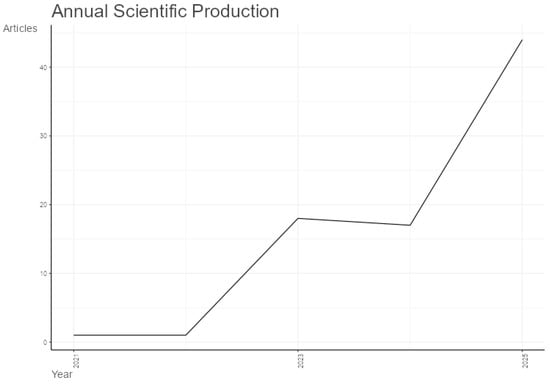
Figure 1.
Distribution of studies by year.
It was observed that the first article study conducted within this scope was conducted in 2021. Therefore, scientific articles published between 2021 and 2025 were included in the scope of the bibliometric analysis. Although the highest number of studies was conducted in 2025 with 44 publications, it is seen that the studies conducted is increasing with an increasing trend. This indicates that the concept of the digital product passport is attracting intense interest with increasing momentum in the scientific field.
This upward trend in the number of publications indicates that interest in research on this subject has increased as a result of the new product passport requirement that came with the European Green Deal. The sharp increase observed in 2025 may reflect the spread of the subject of digital product passports in different disciplines.
4.1.2. Distribution of Studies According to Number of Citations Received
As shown in Figure 2, the trend in citation rates for the concept of the “Digital Product Passport” shows a vertical acceleration, in contrast to the number of publications. The upward trend in the number of publications over the years contrasts with the downward trend in citation rates, particularly in recent years. This discrepancy can be attributed to the inherent citation lag in scholarly communication, where newly published studies take time to be cited. Furthermore, the rapid increase in the number of publications may indicate a shift towards a quantity-quality dynamic in the field, which could weaken the impact of individual studies. This suggests that despite the growing interest in the Digital Product Passport topic, its scientific consolidation is still ongoing. Therefore, the most cited studies in 2021 had a citation rate of 126.0, which is exceptionally high due to the presence of only one highly cited publication in that year.
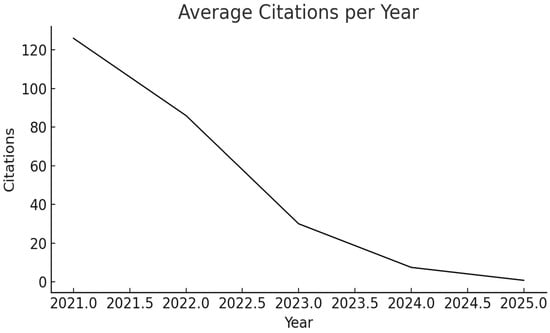
Figure 2.
Average Citations per Year.
4.1.3. Most Relevant Journals
As seen in Figure 3, the first three journals that published the most articles on the theme of ‘Digital product passport’ were Sustainability, Business Strategy and the Environment, Circular Economy and Sustainability. With a total of eight articles, the Sustainability journal became the journal that published the most scientific articles with the relevant keyword.
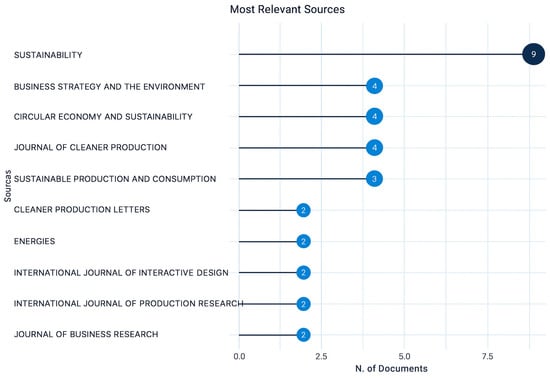
Figure 3.
Most relevant sources.
In Table 2, journals are ranked according to the Hirsch index (H-index), which measures the productivity and citation impact of publications.

Table 2.
Sources local impact by H index.
In the table, the most influential journals are depicted according to their local impact totals. This content is ranked according to the Hirsch index (H-index), which measures the productivity and citation impact of publications from a dataset of 81 scientific articles. Sustainable Production and Consumption emerges as the most influential journal with a total H-index of 3 and 188 citations.
The fact that the most cited journals are largely sustainability-oriented (e.g., Sustainability, Journal of Cleaner Production, Sustainable Production and Consumption) aligns with the circular economy and digital traceability objectives of the Digital Product Passport concept. However, the presence of journals such as Energies, Journal of Business Research, and IJIDeM also indicates that DPP research is increasingly engaging with energy systems, business strategy, and design-oriented applications, suggesting a gradual shift towards more interdisciplinary coverage. This diversification of sources reflects the growing maturity of the field and the integration of DPP into sector-specific and technical research contexts.
4.1.4. Most Active Authors
A total of 100 authors contributed to scientific articles on digital product passports. Figure 4 shows the top 10 most active authors on this concept. Table 3 includes the top 10 most productive authors and their H-indexes between 2021 and 2025. Rupert J. Baumgartner was the most productive author in terms of the total number of publications, accounting for 4.94% of all articles with a total of 4 articles.
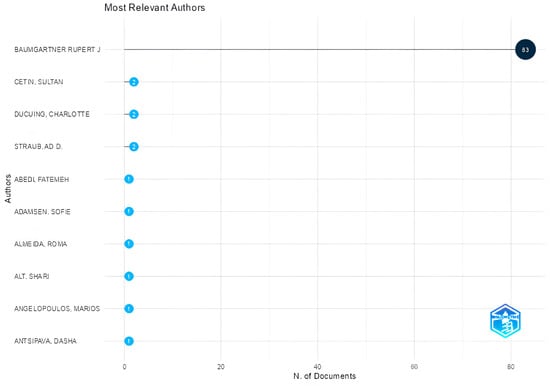
Figure 4.
Most relevant authors.

Table 3.
Top 10 most active authors by H-index.
The concentration of the most productive and influential authors in Austria, Germany, and other European countries (Belgium, the Netherlands, and the Nordic region) underscores the geographically centralized academic interest in DPP research. This distribution reflects the EU’s early adoption of circular economy and traceability policies, making Europe a primary hub for scientific knowledge production on DPP.
4.1.5. Most Relevant Affiliations and Countries
Examining the connections, it is seen that the institution with the most frequent connections of the published articles is Karl-Franzens-Universität Graz, with a total of 11 articles. As shown in Figure 5, it is immediately followed by Delft University of Technology now appears through its specific department, “Afdeling Management in The Built Environment’’ with seven scientific articles. The inclusion of Kyung Hee University reflects an emerging non-European contribution, expanding the global reach of DPP research.
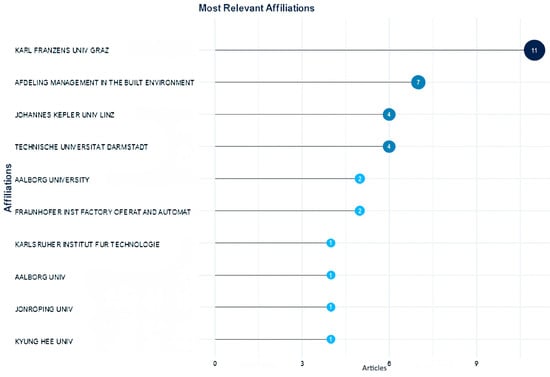
Figure 5.
Most relevant affiliations.
The fact that these institutions have become leading research centers on digital product passports emphasizes their importance in guiding how this concept will be defined and implemented academically in the future.
Figure 6 shows the influential countries in the scientific articles produced on digital product passports, shaped like world maps. Germany, shown in the darkest color, is the most productive country on this topic with 56 articles. The most productive countries and the number of scientific articles are shown in Table 4.
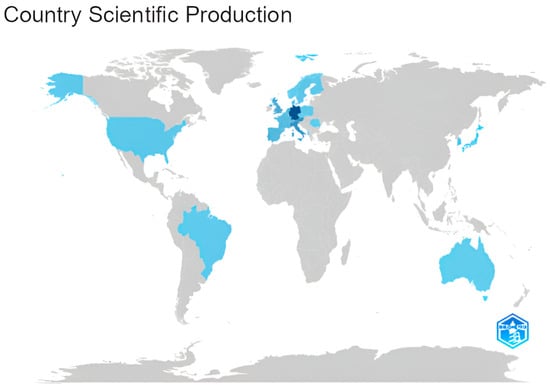
Figure 6.
Most scientific productions.

Table 4.
Top 10 most scientific productions.
In terms of the most effective countries in terms of digital product passports according to citation numbers, Germany ranks first with 221 citations, in line with the most productive countries. This is followed by Austria with 128 citations and the United Kingdom with 70 citations. Figure 7 shows the top 10 most cited countries and their citation numbers.
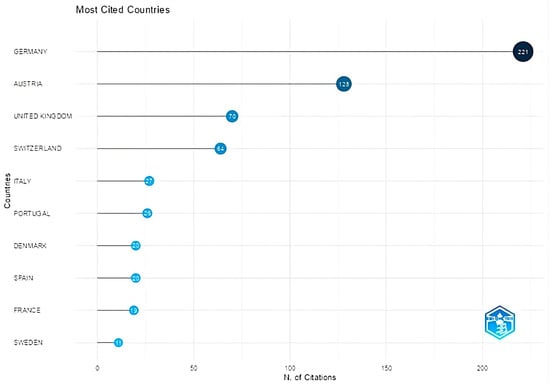
Figure 7.
Top 10 most cited countries.
Germany’s clear lead in both publication and citation measures reflects its role as both a policy maker and a knowledge producer in the field of digital product passports.
4.1.6. Most Cited Publications
Examining the publications and citation numbers for the formation and future of the concept of digital product passport in the literature shows the direction in which the interest in the subject and the literature are evolving. This creates a publication source for future studies. This review can be used to determine which articles are cited in the specified time period, which allows new trends to be identified. The fact that the most influential article was in 2021 indicates that, as previously stated, the studies are mostly new and that the literature areas have expanded with the spread of interdisciplinary studies, which means that the citation rate in new articles is distributed.
The study examined 81 scientific articles with an average of 11.2 citations per article and a total of 918 citations. The top 10 most cited articles were published in 2021, with the top 10 articles accounting for 68.3% of all citations. Table 5 and Figure 8 show the top 10 most cited documents, the most influential of which is Adisorn et al. [17].

Table 5.
Top 10 most globally cited documents.
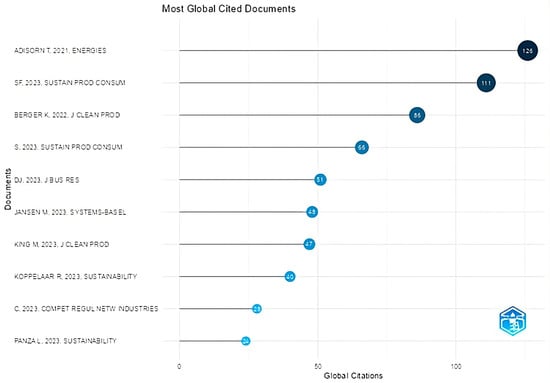
Figure 8.
Top 10 most globally cited documents [7,17,24,25,29,39,40,41,42,43].
As seen in Table 5, the most cited article is Adisorn et al. [17] with a total of 126 citations, followed by Jensen et al. [7] with 111 citations. However, when examining the impact in terms of annual average citations, Jensen et al. [25]. leads with 37 citations per year, indicating an extraordinarily rapid academic acceptance in a short period of time.
These results suggest that while previously published publications presenting the basic conceptual framework continue to be cited as the foundations of the field, the reason why recent publications by authors such as Jensen, Çetin, and King receive high citations shortly after their publication is that they are included in the literature with current policy and practice discourses and important conceptual or methodological contributions [7,17,24,39].
The fact that some authors appear twice in the top 10 reflects the presence of influential leaders in the field with numerous highly cited publications. The high citation rates of new articles demonstrate that the emerging concept of digital product passports has generated quite an interesting sentiment in academia.
4.2. Scientific Mapping and Network Structures
This section examines the collaboration network of keywords, authors, and countries. It also includes thematic collaborations generated from keywords.
4.2.1. Keyword Synchronicity
A total of 401 keywords were used in the 81 articles examined in the study. The most frequently used keyword among these was digital product passport, which was used 44 times. “Circular economy” was used 33 times, and “sustainability” was used 15 times. These results, which are consistent with the literature, express the importance of the concept of digital product passport in terms of circular economy and sustainability. Figure 9 shows the 10 most frequently used keywords and their usage numbers. Figure 10 shows a cloud representation of the most frequently used keywords by all authors. The keyword represented in the thickest form represents the most frequent usage.
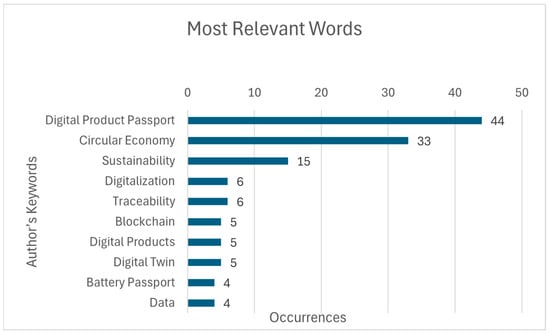
Figure 9.
Top 10 Most relevant words.

Figure 10.
Author’s keyword cloud.
Figure 11 shows the relevance of keywords to one another. It is observed that the most frequently used keywords are “digital product passport”, “circular economy”, and “sustainability”—again, in parallel with the frequency of use.
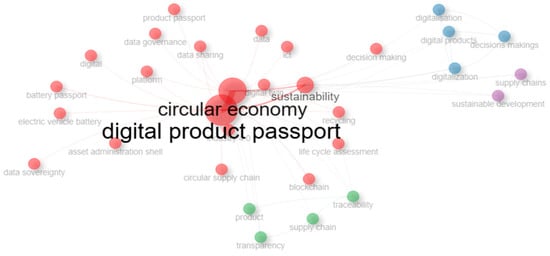
Figure 11.
Relevance of keywords to each other.
The central and intense position of ‘digital product passport’, ‘circular economy’, and ‘sustainability’ in keyword clusters supports the policy understanding and environmental discourse of the subject. In terms of clustering, the red cluster mainly represents policy and sustainability themes, while the green cluster links supply chain and traceability concepts, and the blue cluster reflects digitalization and product data themes, showing the latent thematic structure of DPP research.
It is important to note that the keyword “digital product passport” appeared with the highest frequency because it was the primary search term used to generate the dataset. Therefore, its inclusion in the keyword analysis was expected and reflects the scope of the bibliometric search. To avoid bias, this keyword was interpreted in a general way, taking into account the frequency of other keywords in the discussion of the results.
The keyword analysis shown in Table 6 reveals that policy-oriented and sustainability-related terms dominate the discourse, placing concepts such as “digital product passport,” “circular economy,” and “sustainability” at the center of the research field. The relatively low frequency of technology-specific keywords such as “blockchain” (5), “digital twin” (5), and “battery passport” (4) suggests that the technological perspective is underrepresented. This is because most studies are currently conceptual or policy-oriented, and it is expected that technical implementation and integration studies will follow as the field matures.

Table 6.
Top 10 Keywords by frequency.
4.2.2. Co-Authorship Network
Figure 12 shows the co-authorship network of authors contributing to the Digital Product Passport (DPP) research between 2021 and 2025. Examining the network, the existence of numerous small-scale author collaboration clusters was observed, suggesting that the digital product passport concept is currently in an early, decentralized development phase. This also suggests opportunities for broader collaboration in future research.
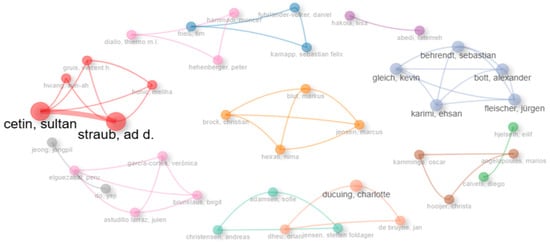
Figure 12.
Co-authorship network map.
The scattered author collaboration networks indicate a decentralized research area. While some strong clusters exist, especially in Central Europe, the overall structure reflects the early-stage and exploratory nature of their work on the concept of digital product passports, which is still a young topic.
The most consistent and influential cluster is led by Sultan Çetin and Ad D. Straub, indicating their central role in shaping early DPP research through repeated co-authorship, in line with what has been noted in previous analyses. Another significant cluster is centered around Charlotte Ducuing, emphasizing the growing body of legal and regulatory studies in this domain.
The map shows that cooperation overall is still fragmented, but the growing size of certain clusters (especially in European institutions) suggests that the field is becoming increasingly connected and mature.
4.2.3. Collaboration Network
Figure 13 shows the cooperation network of countries. The thickness of the lines shows the depth of the relationship. Germany is the country that attaches the most importance to global cooperation and cooperates the most. While Germany cooperates with almost all European countries that publish articles in the literature, another strong cooperation network is observed between the Czech Republic, Poland, Albania, and Portugal.
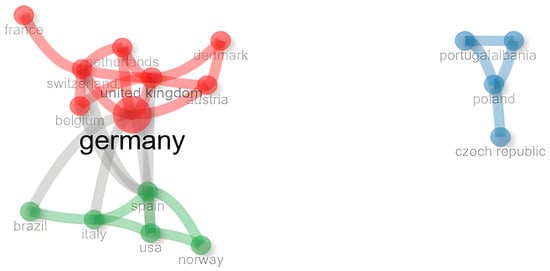
Figure 13.
Country collaboration network.
Table 7 presents the country’s collaboration network and metrics for DPP research. Germany leads the field with 6 publications, an average of 22.7 citations per article, and the highest collaboration strength in the network (0.0802); in this context, Germany’s collaboration strength is more than double that of many other countries. This confirms Germany’s central position and extensive collaboration with nearly all major European contributors, particularly Austria, Switzerland, and the Netherlands, as indicated in Figure 13.

Table 7.
Country collaboration network.
The United Kingdom (15.7 citations per article) and Switzerland (13.3 citations per article) show strong citation performance despite fewer publications, while countries like Austria and Denmark have lower impact factors, reflecting more limited participation.
While most collaborations are concentrated within Europe, the presence of countries like the United States, Brazil, and Norway suggests early steps toward global expansion. These findings suggest that DPP research is still predominantly EU-focused but is increasingly expanding beyond European borders.
4.2.4. Co-Authorship and Institutional Collaboration Networks
Sankey diagrams are used to visualize data flows in various networks and processes. They show quantitative information about flows, their relationships, and transformations. Sankey diagrams represent directed, weighted graphs with weight functions that ensure flow conservation: for each node, the sum of the incoming weights equals the sum of the outgoing weights [44].
Figure 14 presents a Sankey diagram showing the institutional and geographical affiliations of the most productive authors in the field of Digital Product Passports (DPP). The left block (AU_UN) shows the universities to which the authors are affiliated, the middle block (AU_CO) the countries where these universities are located, and the right block (AU) the corresponding authors.
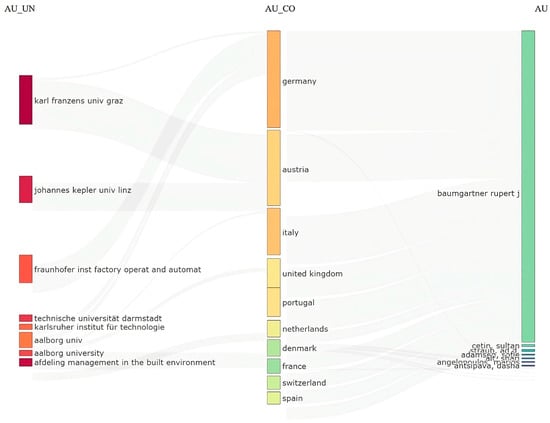
Figure 14.
Sankey diagram of author–institution–country linkages.
The results indicate a particularly intense research activity on this topic at European institutions in Austria, Germany, and Italy. Austria stands out as a hub, with institutions such as the Karl-Franzens University Graz and the Johannes Kepler University Linz having significant connections with prolific authors such as Baumgartner R. This, in line with the emergence of the DPP topic with the European Green Deal, confirms Central Europe’s role as an early adopter of research on DPP policy and practice and as a pioneer of theoretical concept.
The relatively low representation of non-European institutions underscores the regionally concentrated nature of DPP research, which is consistent with the concept’s origins in the European Commission. At the same time, the multiple links with different countries and authors, inter-institutional collaboration, and intra-European research mobility demonstrate that this is a developing and dynamic research area.
4.3. Content/Methodology/Findings Analysis
In addition to bibliometric indicators, a detailed content analysis of 81 articles identified from the Scopus and Web of Science (WoS) databases was conducted to provide a deeper understanding of the knowledge base related to Digital Product Passports (DPPs). Each article was examined according to the following three dimensions:
- Research methodology (conceptual analysis, framework design, model development, case study, systematic review, survey, prototype design, and simulation);
- Theoretical framework (e.g., circular economy, lifecycle thinking, blockchain, supply chain management, sustainability transition, Industry 4.0/5.0);
- Key findings and contributions (e.g., framework recommendations, identification of barriers, traceability improvements, and policy implications).
Furthermore, to highlight the interdisciplinary nature of the reviewed studies, the core disciplines in which the 10 most productive authors mentioned earlier worked are summarized in Table 8. This diversity, encompassing sustainability management, environmental economics, law and policy, engineering design, communication science, energy systems, and IoT, confirms that DPP research is a cross-sectoral and multi-stakeholder field.

Table 8.
Disciplinary backgrounds of the top contributing authors.
As seen in Table 8, the most prolific authors represent disciplines ranging from sustainability management, environmental economics, law, construction management, supply chain, engineering design, communication science, and IoT systems. This broad field of study reinforces the interdisciplinary nature of the topic. This result highlights the cross-sectoral nature of DPP research and highlights the need for collaborative interdisciplinary approaches to advance technical, regulatory, and socioeconomic aspects.
Figure 15 shows the frequency distribution of research methods used. The analysis reveals that conceptual analysis and framework design were used as methods in 23 publications, followed by model development in 14 and case studies in 10. Systematic reviews, surveys, prototype designs, and simulations are less common, indicating that experimental and technical validation studies are still evolving.
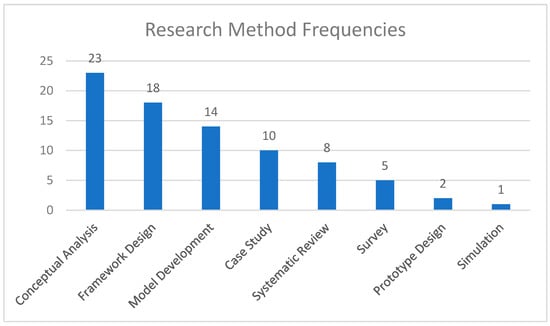
Figure 15.
Frequency distribution of research methods in the reviewed articles.
Figure 16 shows the distribution of theoretical frameworks applied in the reviewed studies. Circular Economy dominates 38 theoretical frameworks and Life Cycle Thinking 31, confirming that most DPP research is based on policy- and sustainability-focused paradigms. The Supply Chain Management and Sustainability Transition theoretical frameworks are also frequently used, reflecting the literature’s emphasis on traceability, material flows, and resource efficiency, as highlighted in the Green Deal. In contrast, Blockchain and Industry 4.0/5.0 appear less frequently, indicating that the technological and digital transformation perspective is still evolving and could represent an important avenue for future empirical research.
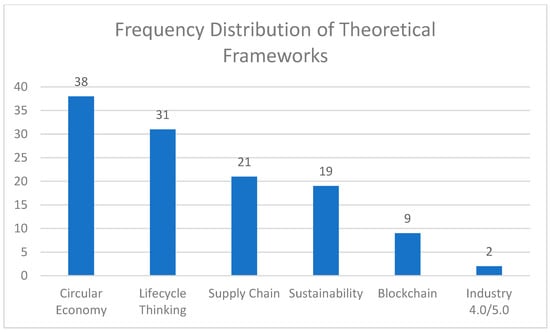
Figure 16.
Frequency distribution of theoretical frameworks in the reviewed studies.
Figure 17 shows the distribution of key findings reported in the reviewed studies. The most common outcome, with a total frequency of 40, is the proposal of conceptual or practical frameworks. This suggests that the field is still in its formative phase, with authors primarily focusing on developing theoretical and design-oriented contributions. Identification of barriers and improvements in traceability are also frequently observed, suggesting that work addressing the practical and policy challenges of DPP implementation is on the agenda. Summaries of trends and demonstrations of positive impacts are relatively less frequent, suggesting that the DPP concept remains an area of research that has yet to receive sufficient empirical validation and implementation results.
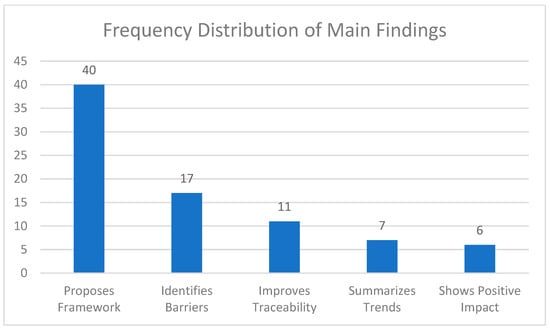
Figure 17.
Frequency distribution of main findings reported in the reviewed studies.
5. Discussion
The bibliometric findings of this study reveal that academic interest in Digital Product Passports (DPP) accelerated significantly between 2021 and 2025, reaching a significant publication peak in 2025. However, this increasing trend in the number of scientific articles is not parallel to the citation activity, which primarily indicates a possible citation lag, as well as a lack of conceptual coherence in the literature. This may indicate that the concept of digital product passports has gained momentum over time by gaining interest in different disciplines.
The abundance of articles in journals primarily related to sustainability, such as Sustainability, Business Strategy and the Environment, and Circular Economy and Sustainability, reflects the environmental framework that underlies the digital product passport discourse. At the same time, the most cited studies tend to be those that provide systematic frameworks or policy-relevant insights, indicating that fundamental or integrative contributions currently receive the most academic attention.
When the author and institutional network analyses are examined, it is seen that the research on the digital product passport is still quite fragmented, with limited international collaboration and few related co-authorship clusters. European institutions in Austria and Germany, in particular, consistently emerge as leading centers for the development of mandatory policy in Europe regarding the digital product passport requirement that came to the agenda with the decision of the European Commission.
Keyword synchronous matching confirms that the literature is primarily clustered around three main themes: circular economy, sustainability, and traceability. This naturally overlaps with the basic components of the digital product passport concept. However, the relatively low occurrence of technology-specific keywords (e.g., blockchain, IoT, digital twins) points to a gap in the technical-operational dimension of the application, which should be addressed in future interdisciplinary research.
According to the research findings, it is critical for the EU to establish financing mechanisms to cover the infrastructure costs of Digital Product Passports (DPPs) to facilitate mandatory compliance, particularly for SMEs. The development of standardized data protocols, open-source platforms, and industry guidelines is vital not only to accelerate DPP adoption within the EU but also to facilitate its global interoperability.
Furthermore, integrating DPP data with real-time Life Cycle Assessment (LCA) and incorporating visual indicators such as ESG scores is expected to strengthen the strategic role of DPPs in advancing sustainability goals across production and consumption systems. Such integration can create a space that increases transparency, promotes responsible consumption, and offers new business opportunities for eco-innovation. Combining DPP data with real-time LCA dashboards and ESG metrics can significantly improve decision-making throughout the product lifecycle.
Additionally, in product categories where sustainability is a priority, such as textiles, electronics, and construction, DPPs can become essential tools for implementing sustainable product policies and increasing accountability across all business processes.
However, one limitation of this study is that DPP is a relatively new concept for bibliometric analysis, and only a small portion of the existing literature covers closely related technical details (e.g., traceability and blockchain). Therefore, examining the applicability of the DPP concept to different digital models across different sectors is crucial. Furthermore, the anticipated increase in regional collaborations in this area, coupled with the transformation policy planned solely for the EU, becoming a global sustainability approach, is an extremely valuable asset.
As proposed in the European Green Deal, the Digital Product Passport should be considered within the context of a fundamental model of twin transition, meaning the simultaneous implementation of digitalization and green transformation. In line with these EU objectives, DPPs can exist as a digital transformation tool, a unique twin transition application to integrate the traceability of all processes with sustainability.
As emphasized in recent studies [45], the transition from Industry 4.0 to Industry 5.0 prioritizes human-centered, resilient, and sustainable production systems. In this context, DPPs serve not only as digital tools but also as socio-technical boundary objects that align digital infrastructure with environmental and social governance (ESG). Establishing robust empirical frameworks, technology-policy integration models, and multi-stakeholder governance mechanisms will be critical to unlocking the full transformative potential of DPPs in the era of twin transition.
Figure 18 illustrates the positioning of the Digital Product Passport within the context of a twin transition, where digital and green transformations are combined to drive systemic change. This framework highlights that DPPs serve as a bridge between circular economy objectives, sustainability goals, and traceability requirements, enabling the integration of policy, technology, and industry practices.
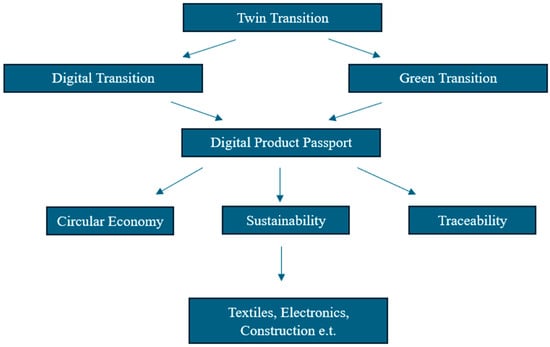
Figure 18.
Proposed strategic integration framework for DPPs in the twin transition era.
Building on this conceptual foundation, several pilot applications built on this conceptual framework demonstrate how DPPs can support the twin transition in practice. In the machinery sector, DPP-enabled battery passports have been used to monitor battery health, schedule maintenance in real-time, and enable second-life applications such as energy storage systems, thereby creating new circular business models. In the logistics sector, DPPs have enabled carbon emissions tracking in the transportation of steel and food products, providing both operators and end-users with transparent and traceable data access via QR codes, demonstrating competitive differentiation. A review of DPP pilots in the textile sector demonstrates how product data, such as recycled content, carbon footprint, and care instructions, can be shared across the value chain, enabling repair services, spare parts sales, and enhanced recyclability [16]. Collectively, these pilots demonstrate that DPPs can act not only as compliance tools but also as strategic assets that unlock innovation and circular economy opportunities across multiple sectors.
The content analysis conducted in Section 4.3 provides additional insight into the bibliometric findings and reveals several important patterns. First, from a methodological perspective, the dominance of conceptual analyses and framework design studies suggests that DPP research is still in its early stages, focusing on theory building and conceptual architecture rather than large-scale implementation. The relatively limited number of case studies and surveys suggests that empirical evidence on the performance of DPP in terms of adoption and implementation is still insufficient. Second, from a theoretical perspective, the dominance of circular economy and lifecycle thinking frameworks highlights the field’s strong policy and sustainability orientation, while the underrepresentation of technology-specific approaches such as blockchain, digital twins, and battery passports suggests that the digital and technical enablers of DPP are not sufficiently established in academic discourse. Finally, the most frequently reported findings focus on proposing new frameworks and identifying barriers, highlighting the need for research that extends beyond problem definition to testing and validating practical solutions. Overall, these results suggest that the field remains conceptually focused and that further empirical work and technical applications are needed.
6. Conclusions
This bibliometric analysis demonstrates that Digital Product Passports (DPPs) are rapidly emerging as a focal point of sustainability-focused digital transformation, particularly in the context of the European Green Deal and the dual transition goals adopted by the European Union. While academic interest has increased significantly in recent years, the fragmented nature of literature, the lack of international collaboration, and the underrepresentation of practical and stakeholder-focused studies highlight critical gaps that need to be addressed through future interdisciplinary research.
In addition to bibliometric indicators, this study also presents a systematic content analysis of 81 articles, mapping the field’s methods, theories, and findings. By systematically integrating bibliometric indicators with the diversity of research methods, theoretical frameworks, and key findings, it provides a more holistic perspective on the current state of DPP studies, highlighting the need for empirical development of the field and the significant lack of cross-national collaboration. Collectively, these insights point to the need for a significant research agenda aimed at bridging the gap between policy concepts and technological implementation. It highlights the importance of interdisciplinary collaboration among management scientists, engineers, policy makers, and technologists.
Based on the insights gained from this bibliometric analysis, it is suggested that a future research agenda should primarily consist of the following:
- Developing DPP architecture in differentiated sectors (e.g., textiles, electronics, construction) that adhere to the principles of twin transformation processes and circular business models;
- Exploring user-centered DPP designs for various stakeholders;
- Implementation of strengthened and interdisciplinary DPP systems in sustainability policy, with the combined use of technologies to be developed (IoT, blockchain, digital twins) and integrated add-ons such as Life Cycle Assessment (LCA) and ESG scores;
- Examining governance models for strengthening transparency and traceability objectives, data ownership, privacy, and security;
- Quantifying the economic and environmental added value provided by adopting DPP as a policy tool.
This study has limitations, including the paucity of interdisciplinary studies and applications, and the fact that the process of disseminating these studies through new collaborations in different countries has only just begun. Therefore, this will provide a collaborative, interdisciplinary research field that not only fills and maps gaps in the literature but also contributes to sectoral and technological applications in the field.
Despite the limitations of the digital product passport concept, related to its novelty and emerging applications, this study highlights the strategic value of developing an interdisciplinary collaborative research environment. Such an environment will not only bridge existing knowledge gaps but also contribute to sectoral and technological advancements. The proposed strategic integration framework outlined in this study provides a roadmap for future work to operationalize DPPs in line with the concept of the twin transitions. In the evolving landscape of digital and green transformation, DPPs are poised to play a transformative role not only as technological enablers but also as institutional tools driving sustainable production and responsible consumption in global value chains.
Author Contributions
Conceptualization, A.N.K., G.Ç. and Z.A.B.; methodology, A.N.K. and G.Ç.; software, G.Ç.; validation, A.N.K. and Z.A.B.; formal analysis, G.Ç.; investigation, A.N.K.; resources, A.N.K. and Z.A.B.; data curation, G.Ç.; writing—original draft preparation, G.Ç.; writing—review and editing, A.N.K. and Z.A.B.; visualization, G.Ç.; supervision, A.N.K. and Z.A.B.; project administration, A.N.K.; funding acquisition, Z.A.B. All authors have read and agreed to the published version of the manuscript.
Funding
This research received no external funding.
Data Availability Statement
No new data were created or analyzed in this study. Data sharing is not applicable to this article.
Conflicts of Interest
The authors declare no conflicts of interest.
Abbreviations
The following abbreviations are used in this manuscript:
| DPP | Digital Product Passport |
| ESPR | Ecodesign Regulation for Sustainable Products |
| EPR | Extended Producer Responsibility |
| EU | European Union |
| SMEs | Small and Medium-sized Enterprises |
| ESG | Environmental Social Governance |
References
- Psarommatis, F.; May, G. Digital Product Passport: A Pathway to Circularity and Sustainability in Modern Manufacturing. Sustainability 2024, 16, 396. [Google Scholar] [CrossRef]
- Neligan, A.; Schleicher, C.; Engels, B.; Kroke, T. Digitaler Produktpass—Enabler der Circular Economy: Relevanz und Umsetzbarkeit durch Unternehmen; IW-Report No. 47; Institut der deutschen Wirtschaft (IW): Berlin/Köln, Germany, 2023; Available online: https://www.iwkoeln.de/fileadmin/user_upload/Studien/Report/PDF/2023/IW-Report_2023-Digitaler-Produktpass.pdf (accessed on 22 July 2025).
- European Union. EU’s Digital Product Passport: Advancing Transparency and Sustainability. 27 September 2024. Available online: https://data.europa.eu/en/news-events/news/eus-digital-product-passport-advancing-transparency-and-sustainability (accessed on 24 June 2025).
- Buzeti, Z.; Daphne, T. A Guide to the Ecodesign for Sustainable Products Regulation (ESPR). Circularise. 1 October 2024. Available online: https://www.circularise.com/blogs/a-guide-to-the-ecodesign-for-sustainable-products-regulation-espr (accessed on 29 July 2025).
- Global Market Insights. Digital Product Passport Market Size–By Component, by Organization Size, by Application, by Vertical, by Lifecycle Stage, Growth Forecast 2025–2034. January 2025. Available online: https://www.gminsights.com/industry-analysis/digital-product-passport-market (accessed on 11 June 2025).
- Markets and Markets. Digital Product Passport (DPP) Markets. January 2025. Available online: https://www.marketsandmarkets.com/Market-Reports/digital-product-passport-market-163607839.html (accessed on 8 June 2025).
- Jensen, S.F.; Kristensen, J.H.; Adamsen, S.; Christensen, A.; Waehrens, B.V. Digital Product Passports for a Circular Economy: Data Needs for Product Life Cycle Decision-Making. Sustain. Prod. Consum. 2023, 37, 242–255. [Google Scholar] [CrossRef]
- Bułkowska, K.; Zielińska, M.; Bułkowski, M. Implementation of Blockchain Technology in Waste Management. Energies 2023, 16, 7742. [Google Scholar] [CrossRef]
- Lopes, C.; Barata, J. Digital Product Passport: A Review and Research Agenda. Procedia Comput. Sci. 2024, 246, 981–990. [Google Scholar] [CrossRef]
- European Commission. The European Green Deal. 2019. Available online: https://ec.europa.eu/info/strategy/priorities-2019-2024/european-green-deal_en (accessed on 21 June 2025).
- European Commission. Commission Staff Working Document Impact Assessment: Proposal for a Regulation of the European Parliament and of the Council Establishing a Framework for Setting Ecodesign Requirements for Sustainable Products. 30 March 2022. Available online: https://op.europa.eu/en/publication-detail/-/publication/ccd71fda-b1b5-11ec-9d96-01aa75ed71a1 (accessed on 29 July 2025).
- European Commission. Green Deal: New Proposals to Make Sustainable Products the Norm and Boost Europe’s Resource Independence. 30 March 2022. Available online: https://ec.europa.eu/commission/presscorner/detail/en/ip_22_2013 (accessed on 29 July 2025).
- European Commission. Proposal for Ecodesign for Sustainable Products Regulation. Directorate-General for Environment. 30 March 2022. Available online: https://ec.europa.eu/environment/publications/proposal-ecodesign-sustainable-products-regulation_en (accessed on 29 July 2025).
- Alcayaga, A.; Berg, H.; Hoffmann, N.; Brüggmann, H.; Maus, F. The Digital Product Passport (DPP) for the Circular Economy: Recommendations for Policy, Business and IT; CIRPASS Consortium: Brussels, Belgium, 2024; Available online: https://cirpassproject.eu/wp-content/uploads/2024/05/CIRPASS_The-DPP-for-the-Circular-Economy-Recommendations-for-policy-business-and-IT_v12.pdf (accessed on 14 July 2025).
- Saari, L.; Heilala, J.; Heikkilä, T.; Kääriäinen, J.; Pulkkinen, A.; Rantala, T. Digital Product Passport Promotes Sustainable Manufacturing: White Paper; VTT Technical Research Centre of Finland: Espoo, Finland, 2022; Available online: https://cris.vtt.fi/en/publications/digital-product-passport-promotes-sustainable-manufacturing-white (accessed on 14 October 2025).
- Sitra. Digital Product Passports: Catalysing Europe’s Sustainable Growth, 2024. Available online: https://www.sitra.fi/wp/wp-content/uploads/2024/04/sitra_digital_product_passports_catalysing_europes_sustainable_growth.pdf (accessed on 29 July 2025).
- Adisorn, T.; Tholen, L.; Götz, T. Towards a Digital Product Passport Fit for Contributing to a Circular Economy. Energies 2021, 14, 2289. [Google Scholar] [CrossRef]
- Zhang, A.; Seuring, S. Digital Product Passport for Sustainable and Circular Supply Chain Management: A Structured Review of Use Cases. Int. J. Logist. Res. Appl. 2024, 27, 2513–2540. [Google Scholar] [CrossRef]
- Basal, M.; Demircioglu, A. Digital Product Passport in Marketing and the Future of Sustainable Development. Am. J. Ind. Bus. Manag. 2024, 14, 759–782. [Google Scholar] [CrossRef]
- Heeß, P.; Rockstuhl, J.; Körner, M.F.; Strüker, J. Enhancing Trust in Global Supply Chains: Conceptualizing Digital Product Passports for a Low-Carbon Hydrogen Market. Electron. Mark. 2024, 34, 10. [Google Scholar] [CrossRef]
- Monteiro, J.; Barata, J.; Gentilini, S. A Digital Twin-Based Digital Product Passport. Procedia Comput. Sci. 2024, 246, 4123–4132. [Google Scholar] [CrossRef]
- Walden, J.; Steinbrecher, A.; Marinkovic, M. Digital Product Passports as Enabler of the Circular Economy. Chem. Ing. Tech. 2021, 93, 1717–1727. [Google Scholar] [CrossRef]
- Voulgaridis, K.; Lagkas, T.; Angelopoulos, C.M.; Boulogeorgos, A.A.A.; Argyriou, V.; Sarigiannidis, P. Digital Product Passports as Enablers of Digital Circular Economy: A Framework Based on Technological Perspective. Telecommun. Syst. 2024, 85, 699–715. [Google Scholar] [CrossRef]
- King, M.R.; Timms, P.D.; Mountney, S. A Proposed Universal Definition of a Digital Product Passport Ecosystem (DPPE): Worldviews, Discrete Capabilities, Stakeholder Requirements and Concerns. J. Clean. Prod. 2023, 384, 135538. [Google Scholar] [CrossRef]
- Jensen, M.; Meisen, T.; Plociennik, C.; Berg, H.; Pomp, A.; Windholz, W. Stop Guessing in the Dark: Identified Requirements for Digital Product Passport Systems. Systems 2023, 11, 123. [Google Scholar] [CrossRef]
- Hakola, L.; Abedi, F.; Nordman, S.; Smolander, M.; Paltakari, J. Smart Tags as Enablers for Digital Product Passports in Circular Electronics Value Chains. Circ. Econ. Sustain. 2025, 5, 2033–2055. [Google Scholar] [CrossRef]
- Popowicz, M.; Pohlmann, A.; Schöggl, J.P.; Baumgartner, R.J. Digital Product Passports as Information Providers for Consumers—The Case of Digital Battery Passports. Bus. Strategy Environ. 2025, 34, 7700–7722. [Google Scholar] [CrossRef]
- Colasante, A.; D’Adamo, I. The Circular Economy and Bioeconomy in the Fashion Sector: Emergence of a “Sustainability Bias”. J. Clean. Prod. 2021, 329, 129774. [Google Scholar] [CrossRef]
- Langley, D.J.; Rosca, E.; Angelopoulos, M.; Kamminga, O.; Hooijer, C. Orchestrating a Smart Circular Economy: Guiding Principles for Digital Product Passports. J. Bus. Res. 2023, 169, 114259. [Google Scholar] [CrossRef]
- Gaido, F.R. The Digital Product Passport (DPP) and the Future of Digital Identities: Regulation, Technology, and a New Token Economy; Social Science Research Network (SSRN): Rochester, NY, USA, 2024. [Google Scholar] [CrossRef]
- Wicaksono, H.; Mengistu, A.; Bashyal, A.; Fekete, T. Digital Product Passport (DPP) Technological Advancement and Adoption Framework: A Systematic Literature Review. Procedia Comput. Sci. 2025, 253, 2980–2989. [Google Scholar] [CrossRef]
- Olsson, A.; Sönnerhed, L. A Systematic Literature Review of Cybersecurity Measures for Digital Product Passports. Master’s Thesis, Jönköping University, School of Engineering, Computer Science and Informatics, Jönköping, Sweden, 2025. Available online: https://hj.diva-portal.org/smash/get/diva2:1980360/FULLTEXT02.pdf (accessed on 29 July 2025).
- Gieß, A.; Möller, F. Exploring the Value Ecosystem of Digital Product Passports. J. Ind. Ecol. 2025, 29, 561–573. [Google Scholar] [CrossRef]
- Tranfield, D.; Denyer, D.; Smart, P. Towards a Methodology for Developing Evidence-Informed Management Knowledge by Means of Systematic Review. Br. J. Manag. 2003, 14, 207–222. [Google Scholar] [CrossRef]
- Cook, D.J.; Mulrow, C.D.; Haynes, R.B. Systematic Reviews: Synthesis of Best Evidence for Clinical Decisions. Ann. Intern. Med. 1997, 126, 376–380. [Google Scholar] [CrossRef]
- Donthu, N.; Kumar, S.; Mukherjee, D.; Pandey, N.; Lim, W.M. How to Conduct a Bibliometric Analysis: An Overview and Guidelines. J. Bus. Res. 2021, 133, 285–296. [Google Scholar] [CrossRef]
- Kasaraneni, H.; Tharayil, S. Automatic Merging of Scopus and Web of Science Data for Simplified and Effective Bibliometric Analysis. Ann. Data Sci. 2022, 11, 785–802. [Google Scholar] [CrossRef]
- Fahamsyah, M.H.; Mawardi, I.; Laila, N.; Shabbir, M.S. Global Islamic Banking Development: A Review and Bibliometric Analysis Using R-Biblioshiny Application. Muqtasid 2023, 14, 69–92. [Google Scholar] [CrossRef]
- Berger, K.; Schöggl, J.-P.; Baumgartner, R.J. Digital Battery Passports to Enable Circular and Sustainable Value Chains: Conceptualization and Use Cases. J. Clean. Prod. 2022, 353, 131492. [Google Scholar] [CrossRef]
- Çetin, S.; Raghu, D.; Honic, M.; Straub, A.; Gruis, V. Data Requirements and Availabilities for Material Passports: A Digitally Enabled Framework for Improving the Circularity of Existing Buildings. Sustain. Prod. Consum. 2023, 40, 422–437. [Google Scholar] [CrossRef]
- Koppelaar, R.; Pamidi, S.; Hajósi, E.; Herreras, L.; Leroy, P.; Jung, H.-Y.; Concheso, A.; Daniel, R.; Francisco, F.; Parrado, C.; et al. A Digital Product Passport for Critical Raw Materials Reuse and Recycling. Sustainability 2023, 15, 1405. [Google Scholar] [CrossRef]
- Ducuing, C.; Reich, R.H. Data Governance: Digital Product Passports as a Case Study. Compet. Regul. Netw. Ind. 2023, 24, 3–23. [Google Scholar] [CrossRef]
- Panza, L.; Bruno, G.; Lombardi, F. Integrating Absolute Sustainability and Social Sustainability in the Digital Product Passport to Promote Industry 5.0. Sustainability 2023, 15, 12552. [Google Scholar] [CrossRef]
- Riehmann, P.; Hanfler, M.; Froehlich, B. Interactive Sankey Diagrams. In Proceedings of the IEEE Symposium on Information Visualization (INFOVIS 2005), Minneapolis, MN, USA, 23–28 October 2005; pp. 233–240. [Google Scholar] [CrossRef]
- Ciucu-Durnoi, A.N.; Delcea, C.; Stănescu, A.; Teodorescu, C.A.; Vargas, V.M. Beyond Industry 4.0: Tracing the Path to Industry 5.0 through Bibliometric Analysis. Sustainability 2024, 16, 5251. [Google Scholar] [CrossRef]
Disclaimer/Publisher’s Note: The statements, opinions and data contained in all publications are solely those of the individual author(s) and contributor(s) and not of MDPI and/or the editor(s). MDPI and/or the editor(s) disclaim responsibility for any injury to people or property resulting from any ideas, methods, instructions or products referred to in the content. |
© 2025 by the authors. Licensee MDPI, Basel, Switzerland. This article is an open access article distributed under the terms and conditions of the Creative Commons Attribution (CC BY) license (https://creativecommons.org/licenses/by/4.0/).